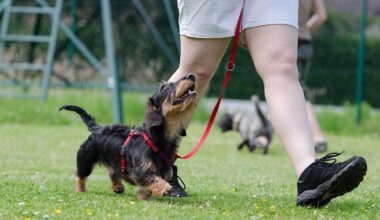Advanced Training Techniques for Effective Guard Dogs
Guard dogs play a crucial role in providing security and peace of mind, especially in today’s unpredictable environment. The effectiveness of a guard dog largely depends on its training. Advanced training techniques help in increasing the dog’s responsiveness, reliability, and ability to assess potential threats. Training must begin at a young age, where socialization is vital. Exposing dogs to various environments, people, and other animals enables them to adapt and react appropriately in different situations. Successful guard dog training emphasizes positive reinforcement. By rewarding the dog for desired behaviors, trainers can cultivate a steadfast bond and encourage obedience. Command training also includes teaching basic commands, which helps reinforce discipline. Commands such as ‘stay,’ ‘sit,’ and ‘come’ are fundamental. Additionally, obstacle courses can greatly enhance agility and focus during practice. Developing these skills is crucial as they prepare dogs for real-life situations. Regular physical activity and mental exercises keep the dog alert and engaged during training sessions, ensuring that it remains effective and sharp. Ultimately, advanced techniques foster a reliable protector that will guard its owner with loyalty and instinct.
Understanding the Role of Commands
Proper command training is essential for effective guard dogs. Dogs must learn various commands to ensure they can respond appropriately to both situational needs and commands from their handlers. The primary commands, such as ‘heel,’ ‘sit,’ ‘stay,’ and ‘down,’ form the foundation for further training. Without mastering these fundamentals, advanced techniques may not be as effective.
Dogs should receive commands clearly and consistently to avoid confusion. It is crucial that trainers use the same verbal cues, along with hand signals, to promote understanding. As dogs advance in training, introducing more complex commands related to protection and guarding becomes necessary. For instance, the command ‘watch’ directs the dog to focus on a perceived threat. Likewise, the instruction ‘protect’ cues the dog to take action when a potential threat approaches. Practicing these commands in various environments helps maintain the dog’s focus and attentiveness. Moreover, incorporating distractions during training exercises ensure dogs stay vigilant. Trainers must also be patient as repetition and reinforcement are key to long-lasting command retention and obedience, ultimately leading to better security outcomes.
Another essential element in training guard dogs is socialization. Proper socialization helps dogs differentiate between normal activities and actual threats. When dogs encounter various people, environments, and other animals during their early development, they become better equipped to assess potential risks. This exposure entails introducing the dog to different environments, such as busy streets, parks, and various individuals. Moreover, dogs should be allowed to interact with both friendly and unfamiliar individuals. The goal is to allow dogs to remain calm and collected during diverse encounters. Socialization provides the opportunity for positive experiences that enhance the dog’s confidence. It helps develop a sense of appropriate behavior, thus enabling them to determine when aggression may be necessary. Furthermore, positive reinforcement should be encouraged throughout the socialization process. Praising and rewarding the dog for maintaining control during potentially stressful scenarios fosters a strong bond between the trainer and the dog. Remember, the objective is to ensure that the dog can protect its handler effectively while being able to navigate day-to-day situations without unnecessary aggression or fear.
Physical Conditioning and Agility Training
Physical conditioning plays a vital role in enhancing the capabilities of a guard dog. A well-conditioned dog possesses stamina, agility, and strength, which are all crucial for effective protection work. Consequently, it is essential to implement an exercise regimen that strengthens muscle tone and enhances endurance. Daily walks and runs are critical, allowing dogs to expend energy while simultaneously improving cardiovascular fitness. Incorporating agility drills into training sessions significantly sharpens the dog’s physical capabilities. Activities such as obstacle courses, weaving through cones, and jumping over barriers improve coordination and flexibility. Moreover, agility training stimulates the dog’s mind, which is pivotal for maintaining focus. The goal is to create a well-rounded guard dog that can swiftly respond to threats while navigating its surroundings with ease. Additionally, handlers should consider specific exercises that improve the dog’s bite force and grip strength. Scent detection training can also be beneficial in improving focus and concentration. Consistent physical activity will promote overall health and longevity, ensuring the dog remains capable of performing its guarding duties competently throughout its life.
Incorporating scent training can significantly enhance a guard dog’s efficacy. Scent is an invaluable tool for detection and recognition, allowing dogs to identify potential threats or intruders more effectively. Encouraging dogs to utilize their sense of smell develops their natural instincts and further enhances their guarding abilities. Scent training can involve various exercises, such as hiding items or using scent trails. By teaching dogs to identify specific odors, handlers can prepare them for various practical situations. For instance, scent detection can be used to identify intruders entering a designated area or locate missing individuals. Importantly, integrating scent training in conjunction with command training ensures that dogs remain attentive and focused on the task. Another vital aspect of scent training is using the proper tools, such as specific scents or toys that motivate dogs to engage and succeed in detecting. It’s crucial to provide consistent rewards and praise when dogs successfully follow a scent trail or identify a target. By doing so, the bond between handler and dog strengthens, which ultimately contributes to a stronger working relationship and improved guard capabilities.
Behavior Management Techniques
Behavior management is critical in ensuring guard dogs maintain control and focus during training and real-life situations. Addressing behavioral issues early on is essential, as they can hinder training progress and effectiveness. One common problem that can arise is excessive barking, which must be managed appropriately. It is vital to discern between protective barking and unnecessary vocalization so that the dog only alerts when necessary. Trainers can use techniques such as positive reinforcement to correct unwanted behaviors and encourage desirable responses. Additionally, identifying triggers that cause unwanted reactions enables handlers to better manage situations. For example, if a dog reacts negatively to strangers, desensitization exercises can be implemented gradually to expose them safely. Recognizing the importance of establishing a consistent routine in training is also crucial. Regular practice sessions create a sense of predictability, helping dogs understand what is expected of them. Concurrently, ensuring the dog is well-socialized develops essential coping mechanisms, allowing them to remain composed in various situations. Building a strong bond through consistent communication will foster an environment of trust, which is the cornerstone of effective behavior management.
Finally, continuing education and training refreshers are vital for maintaining a guard dog’s skills over its life span. Just like any other skill or behavior, guard dog abilities require ongoing practice to remain sharp and effective. Advanced training techniques can include revisiting trust-building exercises, enhancing command training, or even participating in workshops and seminars focused on guard dog training. Incorporating new stimuli or challenges is also necessary to ensure the dog faces various situations. Further, trainers can periodically assess skill levels to identify areas needing improvement, which can enhance performance significantly. Reinforcing previously learned skills helps guard dogs remain proficient while also developing new abilities. Additionally, handlers must prioritize their ongoing education to stay updated with the latest training methods. They may learn innovative techniques and gather insights from expert trainers in their field. By fostering a culture of continual improvement and engagement, both the handler and the dog can thrive. Ultimately, investing time and effort into ongoing training can yield significant long-term benefits, resulting in a reliable, effective, and loyal guard dog that can protect those they love.


